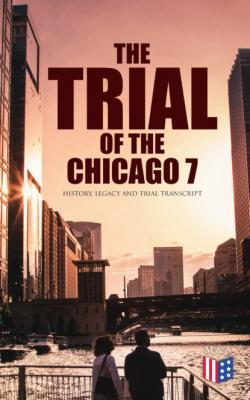ТОП просматриваемых книг сайта:
The Trial of the Chicago 7: History, Legacy and Trial Transcript. Bruce A. Ragsdale
Читать онлайн.Название The Trial of the Chicago 7: History, Legacy and Trial Transcript
Год выпуска 0
isbn 4064066383282
Автор произведения Bruce A. Ragsdale
Жанр Документальная литература
Издательство Bookwire
Everyone in the courtroom took notice of the daily coverage of the trial by national print and broadcast media. The defendants’ antics and the long list of celebrity witnesses guaranteed an audience well beyond the judge and jury. The defense held daily press conferences during the lunch break until the judge warned them not to comment on the trial in public. Judge Hoffman proved to be equally adept at attracting press comment, and the chief judge of the court later acknowledged that Judge Hoffman “loved the publicity, bad as it was.”
The defendants cultivated media coverage outside of the courtroom in their efforts to convince the public that the court proceedings amounted to a political rather than a criminal trial. At night defendants spoke to community meetings and attended fundraisers held by wealthy supporters. One weekend, the defendants traveled to Washington to join a half-million people at a rally against the Vietnam War. Their public appearances could have a less serious side as well. On a visit to Chicago’s Second City comedy club, Abbie Hoffman responded to an audience request with a 45-minute satire of Judge Hoffman. In December 1969, the defendants posed in a group photo for a holiday card that urged recipients to “Make a New Year’s Resolution—Join the Conspiracy.”
Demonstrators during the Democratic National Convention, 1968
Courtesy of the Chicago History Museum.
Washington Post writer Nicholas Van Hoffman noted within the first weeks of the trial that the proceedings had none of the expected characteristics of a criminal trial. “No one here at the Great Conspiracy Trial thinks of its outcome in terms of guilt or innocence. You are for the government or for the defendants.” A Chicago Sun-Times reporter found the trial “more sideshow than criminal proceeding.”
Outside the courtroom, the cultural and political clashes of convention week played on as background for the trial. A series of protests and demonstrations, most of them small and many barely related to the trial, appeared outside the courthouse. The violence of convention week threatened to reappear in October 1969 during the self-styled “Days of Rage” organized by the Weatherman group and other radical groups emerging from the break up of the Students for a Democratic Society. Protestors clashed with Chicago police and smashed store windows, at one point attempting to reach the hotel where Judge Hoffman and his wife lived.
Very different groups of protestors approached the court to protect defendants’ right to representation. When Judge Hoffman threatened to hold the pretrial team of defense lawyers in contempt, nationally prominent lawyers and law professors, including future federal judges, converged on the courthouse to demand a mistrial.
Courtroom drawing of Bobby Seale, seated, bound and gagged during the Chicago conspiracy trial
Howard Brodie, artist. 1969. Library of Congress,
Prints and Photographs Division [LC-USZC4-4870].
The gagging of Bobby Seale, Judge Hoffman’s consistently pro-government rulings, and the ill-defined requirements for conviction on the conspiracy charge led many in the press to question the impartiality of the judicial system. Tom Wicker of the New York Times asked if the burden of proof “any longer means anything.” J. Anthony Lukas noted the many observers “who view what they regard as the excesses on both sides as damaging to the American judicial process and raising questions as to how a court can effectively dispense justice in cases which arouse such strong political passions.” The defendants were only too willing to foster these doubts about justice in the federal courts. Rennie Davis said that “Judge Hoffman presides in every court in this country.” Alternatively, the letters to the editors of Chicago newspapers indicated popular support for Judge Hoffman.
The guilty verdict for five of the defendants brought familiar popular protests, including a crowd of 5,000 outside the Chicago courthouse and another demonstration in Washington, D.C., where more than 100 people were arrested. The several appeals that brought reversals of the convictions and a rebuke of Judge Hoffman were prominently reported by the national press, but the popular interest in the case never again rose to the levels seen during the trial phase. The proceedings in the court of appeals had none of the dramatic interest of the trial, and, perhaps more important, the protest movement evident at the Democratic convention declined following the killings at Kent State University in the spring of 1970.
Historical Documents
Table of Contents
Testimony of Abbie Hoffman, December 23 & 29, 1969
Testimony of Rennie Davis, January 24, 1970
Assistant U.S. Attorney Richard Schultz, closing argument for the government, February 11, 1970
Leonard Weinglass, closing argument for the defendants, February 12, 1970
William Kunstler, closing argument for the defendants, February 13, 1970
U.S. Attorney Thomas Foran, closing argument for the government, February 13, 1970
Judge Hoffman, charge to the jury, February 14, 1970
“The Strategy of Confrontation,” report of the Daley administration
The committee to defend the conspiracy
Tom Wicker, “‘Other Thoughts’ in Chicago”
Конец ознакомительного фрагмента.
Текст предоставлен ООО «ЛитРес».
Прочитайте эту книгу целиком, купив полную легальную версию на ЛитРес.
Безопасно

